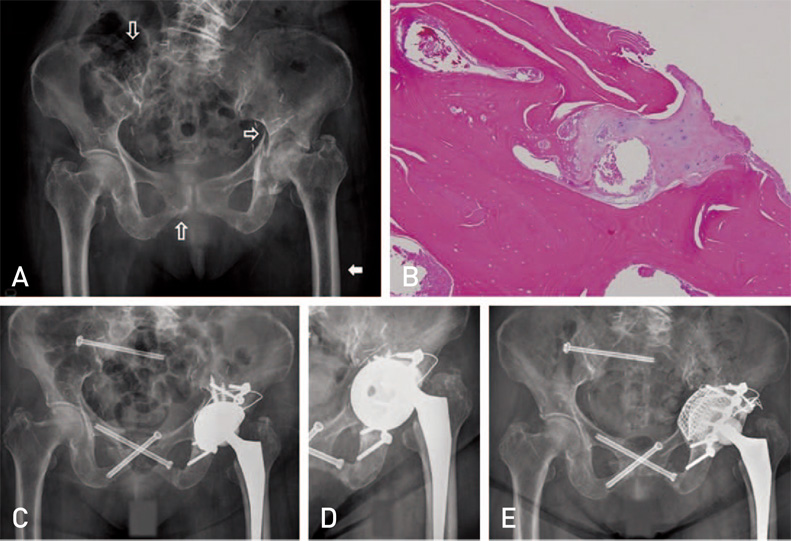Hip Pelvis.
2017 Dec;29(4):286-290. 10.5371/hp.2017.29.4.286.
Acetabular Insufficiency Fracture Following Prolonged Alendronate Use and the Failure of Total Hip Arthroplasty in “Frozen†Bone: Two Cases Report
- Affiliations
-
- 1Department of Orthopaedic Surgery, Kyung Hee Medical Center, Kyung Hee University College of Medicine, Seoul, Korea. yjcho@khmc.or.kr
- 2Department of Orthopaedic Surgery, Hallym University Hangang Sacred Heart Hospital, Hallym University College of Medicine, Seoul, Korea.
- 3Department of Orthopaedic Surgery, Kyung Hee University Hospital at Gangdong, Kyung Hee University College of Medicine, Seoul, Korea.
- KMID: 2424256
- DOI: http://doi.org/10.5371/hp.2017.29.4.286
Abstract
- Atypical insufficiency fracture of the femur following prolonged bisphosphonate use is well described. Regardless of the cause, insufficiency fracture of the acetabulum is extremely rare, and no reports have described insufficiency fractures of the acetabulum that are associated with prolonged bisphosphonate use. This report demonstrates the possibility of insufficiency fracture at the acetabulum following long-term alendronate use and the necessity of particular care in managing insufficiency fractures in "frozen" bone. We describe two cases of insufficiency fracture of the acetabulum following 6 years of alendronate use. Given the patients' medical histories and bone biopsy findings, these insufficiency fractures were thought to be attributable to alendronate use. One case involved the left hip and the presence of pelvic fractures on the opposite side. The patient was treated using cementless total hip arthroplasty (THA), which failed 1 year after surgery. The hip was revised with a massive bone graft and a supportive wire mesh. The other case was managed via THA with a Ganz reinforcement ring due to concerns regarding the use of a cementless implant.
MeSH Terms
Figure
Reference
-
1. Bone HG, Hosking D, Devogelaer JP, et al. Ten years' experience with alendronate for osteoporosis in postmenopausal women. N Engl J Med. 2004; 350:1189–1199.
Article2. Odvina CV, Zerwekh JE, Rao DS, Maalouf N, Gottschalk FA, Pak CY. Severely suppressed bone turnover: a potential complication of alendronate therapy. J Clin Endocrinol Metab. 2005; 90:1294–1301.
Article3. Ahn DK, Kim JH, Lee JI, Kim JW. Bilateral femoral neck insufficiency fractures after use of a long-term anti-resorptive drug therapy for osteoporosis: A case report. Hip Pelvis. 2015; 27:115–119.
Article4. Goh SK, Yang KY, Koh JS, et al. Subtrochanteric insufficiency fractures in patients on alendronate therapy: a caution. J Bone Joint Surg Br. 2007; 89:349–353.5. Cooper KL. Insufficiency stress fractures. Curr Probl Diagn Radiol. 1994; 23:29–68.
Article6. Ozaki D, Shirai Y, Nakayama Y, Uesaka S. A case report of insufficiency fracture of the Fossa acetabuli in a patient with rheumatoid arthritis. J Nippon Med Sch. 2000; 67:267–270.
Article7. Robinson SP, Hammoud S, Sculco TP. Insufficiency fracture of the acetabular medial wall. J Arthroplasty. 2007; 22:768–770.
Article8. Nieves JW, Cosman F. Atypical subtrochanteric and femoral shaft fractures and possible association with bisphosphonates. Curr Osteoporos Rep. 2010; 8:34–39.
Article9. Ott SM. Fractures after long-term alendronate therapy. J Clin Endocrinol Metab. 2001; 86:1835–1836.
Article10. Ries MD. Review of the evolution of the cementless acetabular cup. Orthopedics. 2008; 31:12 Suppl 2. pii: orthosupersite.com/view.asp?rID=37178.
- Full Text Links
- Actions
-
Cited
- CITED
-
- Close
- Share
- Similar articles
-
- Total Hip Replacement in Acetabular Insufficiency
- Periprosthetic Acetabular Fracture after Total Hip Arthroplasty: A Report on Two Cases
- Total Hip Arthroplasty Following Acetabular Fracture
- Total Hip Arthroplasty after Fracture of the Acetabulum
- A Case of Periprosthetic Fracture of Acetabulum Associated with Osteolysis



